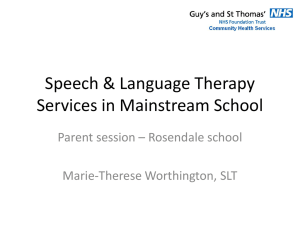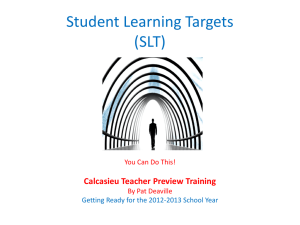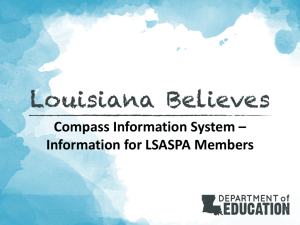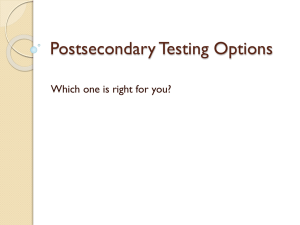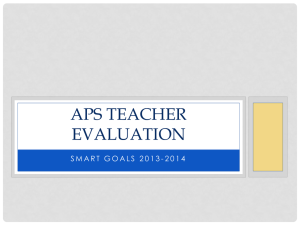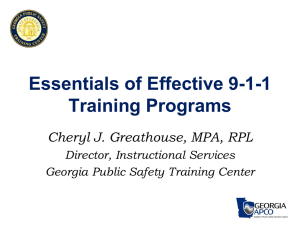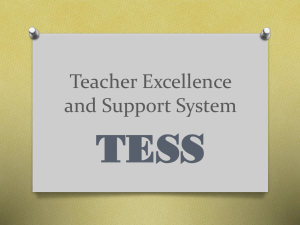Compass Creative Arts SLTs
advertisement
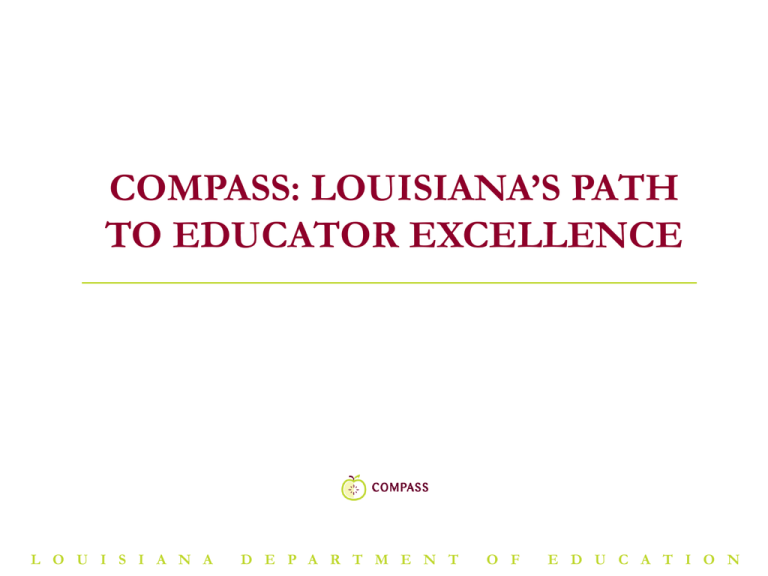
COMPASS: LOUISIANA’S PATH TO EDUCATOR EXCELLENCE L O U I S I A N A D E P A R T M E N T O F E D U C A T I O N The Core Elements help us envision what Common Core & Compass look like in everyday practice. The implementation of Common Core & Compass will look different in every district and school, but the Core Elements represent the foundation for successful, integrated implementation of these two instructional priorities in everyday practice. We believe that all five elements are central to achieving better student outcomes. Five Core Elements 1. GOAL SETTING: Teachers in all subjects will set quantifiable achievement goals for students. 2. ASSESSMENT AND CONTENT: Teachers in all subjects will select assessments and curricular materials that align with skills students are expected to demonstrate on new Common Core assessment items. 3. FEEDBACK: Principals and other instructional leaders will observe all teachers and will provide feedback based on a Common Core-aligned rubric. 4. COLLABORATION: Teachers will work in teams to examine student work and to articulate specific changes in instructional practice that will align student performance to Common Core standards. 5. IDENTIFYING LEADERS: Districts will use Compass effectiveness ratings to identify teacher leaders who can take on new responsibilities to support these Core Elements in their schools. 2 Compass focuses on supporting teachers, which will promote effective instruction and student achievement. Set Goals -For Educators -For Students Observation Feedback Support Evaluate Performance -Student Growth -Prof. Practice Use Data to inform decision making 3 Compass’s requirements are a foundation that districts will build on to meet local needs and achieve their vision. Professional Practice Student Growth • Student Learning Targets • Value-added Score, where available 50% 50% 1.00 – 4.00 1.00 – 4.00 • Measured using the Compass Teacher Rubric (or alternative) • Minimum of TWO observations (one formal, announced; one informal) 1.00 – 1.49 1.50 – 2.49 2.50 – 3.49 3.50 – 4.00 Ineffective Effective: Emerging Effective: Proficient Highly Effective 4 COMPASS: LOUISIANA’S PATH TO EDUCATOR EXCELLENCE O B S E RVA T I O N RU B R I C L O U I S I A N A D E P A R T M E N T O F E D U C A T I O N Louisiana’s Components of Effective Teaching reflect the highest-impact instructional skills. SETTING INSTRUCTIONAL OUTCOMES MANAGING CLASSROOM PROCEDURES USING QUESTIONING AND DISCUSSION TECHNIQUES ENGAGING STUDENTS IN LEARNING USING ASSESSMENT IN INSTRUCTION o Based on feedback from the Compass pilot districts, the LDOE recommended and BESE adopted a set of five instructional components that are the most likely to lead to improved practice and student success. o These components serve as the State’s definition of effective teaching and are included in the Compass Teacher Rubric, an abridged version of Charlotte Danielson’s Framework for Effective Teaching. Districts using alternative rubrics have ensured that their observation rubrics align with these components. 6 Each component in the Compass Teacher Rubric is described generally via elements and indicators… 7 …and more specifically via detailed descriptions, attributes, and examples for each performance level. 8 COMPASS: LOUISIANA’S PATH TO EDUCATOR EXCELLENCE S T U D E N T L E A R N I N G TA R G E T S L O U I S I A N A D E P A R T M E N T O F E D U C A T I O N Determining the Correct Student Growth Measure Do you teach one or more of the following courses? 3rd grade ELA and/or Math 4th-8th grade ELA/Reading, Math, Science, and/or Social Studies Algebra 1 Geometry YES Do you meet the value-added criteria? Teach at least 10 students who are enrolled in your class for the majority of the academic term. Students have at least one year of prior achievement data YES Your impact on student growth will be measured by the Value-Added Model. NO NO Do you provide direct instruction or instructional support to a specified group of students to whom you are formally assigned? OR Are you a librarian or school counselor? YES Your impact on student growth will be measured by Student Learning Targets. NO You will not receive a student growth score. 10 Setting goals for students is essential instructional practice, and nothing new for strong educators. “Goal-setting” is the first of Louisiana’s Five Core Elements. 1. GOAL SETTING: Teachers in all subjects will set quantifiable achievement goals for students. Goals provide the motivation, focus, and accountability necessary to promote student achievement. They set a vision for what students should be able to accomplish by the year’s end. The process itself promotes teachers’ thoughtful engagement with their content and consideration of their students’ needs. There is no single way to engage in the goal setting process. With the support of their school leaders, teachers must determine ambitious yet reasonable goals for the students in their room. Checking in on goals throughout the school year gives administrators the information they need to ensure that teachers and students are on track and to intervene when they are not. 11 SLTs: Definition Student Growth • Student Learning Targets (1.0 -4.0) • Value-added Score, where available (1.0 – 4.0) Professional Practice 50% 1.00 – 4.00 50% 1.0 0– 4.00 • Measured using the Louisiana Teacher Rubric (or alternative) • Minimum of TWO observations An SLT is a measureable goal for student achievement over a given period of time that reflects an ambitious, but reasonable, expectation of growth. Strong SLTs: Prioritize content that is aligned to Common Core State Standards or other national, state, or local standards; Articulate rigorous but reasonable expectations for student growth; and Identify a high-quality assessment to measure student progress. 12 An SLT represents what students should learn and have learned. This is the heart of our work. Clear, ambitious, measurable goals for students are nothing new in education. Strong educators across the state already embrace goals, use them to guide instruction, and hold themselves accountable for achieving goals. SLTs provide a frame for goal setting that allows: • Teachers, with the support of their school leaders and evaluators, to establish the best and most appropriate aspirations for their students. • Evaluators, teachers, students and stakeholders to have a shared understanding of what will be accomplished during the year. • All of us to use a common measure of and language for accountability. By design, the process for setting SLTs is not prescriptive. Teachers must use their vision, expertise, and professional judgment to determine what their students can achieve. School leaders and evaluators must support and inspire teachers throughout this process. 13 What is an SLT? 14 How Does the Annual SLT Process Work? Summer • Districts determine strategy for standardizing targets and/or assessments Beginning of Year Mid-Year End of Year • Teachers set • Teachers and • Evaluators at least two evaluators assign targets and monitor teachers a define what progress final rating performance toward targets based on will look like at students’ • Teachers and each level of progress evaluators effectiveness towards target update using the • Evaluators targets if agreed upon and teachers assignment or definitions of agree on student effectiveness targets based population from the on three changes beginning of characteristics significantly the year 15 Four Steps to Writing Strong SLTs Define the Content Identify Assessment & Collect Baseline Identify the Student Group Set the Growth Target & Scoring Plan Step 1: Define the Content Step 2: Identify the Assessment & Collect Baseline Data Step 3: Identify the Student Group Step 4: Set the Growth Target & Aligned Scoring Plan 16 Step One: Define the Content Define the Content Identify Assessment & Collect Baseline Identify the Student Group Set the Growth Target & Scoring Plan Teachers should define the content that is most important for students to learn during their time in that particular class or course. Prioritize content that is aligned to the Common Core State Standards whenever possible. Look to other national, state, or local standards in identifying the content that students should learn by the end of the course. 17 Step Two: Identify the Assessment & Collect Baseline Data Define the Content Identify Assessment & Collect Baseline Identify the Student Group Set the Growth Target & Scoring Plan Teachers identify the most appropriate assessment to measure students’ mastery of the identified content. Refer to the LDOE Common Assessment List or specific district guidance. If a common assessment is unavailable, teachers and evaluators agree on the most appropriate assessment. When no or few common assessments are available, consider collaboratively designing assessments at the school- or district-level. Teachers gather baseline data about students’ starting points. Data sources may include: Pre-test aligned to the final assessment Diagnostic exam designed to assess students’ readiness for new content Analysis of data from the end of the previous course or year 18 Step Three: Identify the Student Group Define the Content Identify Assessment & Collect Baseline Identify the Student Group Set the Growth Target & Scoring Plan SLTs may be set for: Entire classes of students Multiple sections of the same course Smaller groups, such as the lowest performing students Teachers should try to address the majority of their students across their two or more SLTs Teachers should prioritize academic content areas most aligned to the Common Core. 19 Step Four: Set the Growth Target & Aligned Scoring Plan Define the Content Identify Assessment & Collect Baseline Identify the Student Group Set the Growth Target & Scoring Plan For each target, teachers will set the expectation for student growth, a goal that is ambitious – a bit of a stretch for students – but still attainable. Then, teachers and evaluators agree on a well-defined scoring plan for the SLT, as exemplified below. 20 Exemplary Growth Target for English II Example: English II I decided to develop a pre-test based on English II items from Eagle to determine how many of my students are starting the year at grade level. When I gave this test: 52 of 90 (58%) got at least half the questions right. Students need to get 60% of items right to earn a score of Good, so all of these students should be able to score Good or Excellent on the English II EOC. 20 of 90 (22%) got about 40-50% of the questions right. Some of these students should score Good or Excellent on the English II EOC. 18 of 90 (20%) scored below 40%. These students will need more intensive support to catch up to grade level, but a few of them should be able to score Good or Excellent on the English II EOC with this support. I will set a separate growth target for these students. At my school last year, classrooms with similar baseline data had approximately 65% of students score Good or Excellent. Given this data, I am setting a goal that 70% of students (63 of the 90 students) will score Good or Excellent on the English II EOC. 21 Scoring Plan for English II Example: English II Target: 63 out of 90 students will score Good or Excellent on the English II EOC. 22 Calculating the Student Growth Score At the end of the instructional period, score each SLT according to the Scoring Plan. Average the scores to yield the final Student Growth Score. At the end of each SLT period (typically the end of school year), evaluators will review student performance data to determine each SLT score (based on the scoring plan). To combine SLT scores at the end of the year, average with equal weight. SLT #1: 3 SLT #2: 2 Student Growth Score: 2.50 23 Example: Calculating the Final Score Professional Practice COMPONENT OBSERVATION 1 SCORE OBSERVATION 2 SCORE 1 2 3 4 5 AVERAGE 1 3 2 3 2 2.2 3 3 3 4 2 3 FINAL SCORE Student Growth SLT Score 1 3 Average 2 ` 2 2.50 2.60 2.55 - Effective: Proficient 24 Review: Calculating Final Scores Student Growth Score (SLT rating OR value-added score) 50% 50% 1.00 – 4.00 1.00 – 4.00 Professional Practice Score (average of all observation scores, from minimum two observations) FINAL SCORE (average of Student Growth and Professional Practice scores) 1.00 – 1.49 1.50 – 2.49 2.50 – 3.49 3.50 – 4.00 Ineffective Effective: Emerging Effective: Proficient Highly Effective A rating of Ineffective in either Student Growth or Professional Practice will result in an overall rating of Ineffective. 25 Naturally, teachers will be curious how evaluations affect their job security. Question: Are these evaluations just an excuse to get rid of teachers? Potential responses: No. Evaluations are meant to be tools to help teachers and, therefore, help their students succeed. All professionals need feedback in order to improve their performance. In the past, many teachers were not evaluated or received very minimal information about their performance. Through Compass, observations will help us give you more useful feedback and professional development that relates directly to your teaching practice. We are partners in this work. My job is to provide you with the feedback and support you deserve as a professional. By law, however, teachers who are very low performing or who do not improve will be dismissed. This is so that students have access to strong teachers who help them meet rigorous learning goals. 26 Louisiana believes that every child can achieve. We believe that every child can attain a college degree or pursue a professional career. To reach this goal we must raise our expectations for every student and every teacher. If we believe in children, we also have to believe in the educators closest to them. 27 Questions? Contact: Compass@la.gov or visit http://www.louisianaschools.net/compass/ 28
